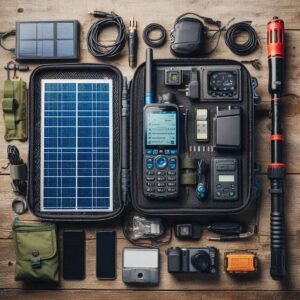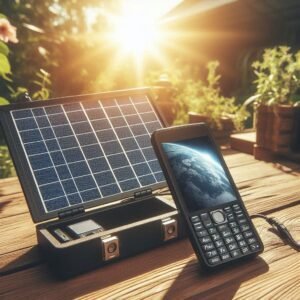Your Complete Guide to Devices, Networks & Service Plans
Picture this: You’re hiking deep in the Rockies when a severe storm hits. Your cell phone shows no signal, the wife drops her iPhone and it cracks bad.
Now no possible iPhone satellite SOS mode and you realize you’re completely cut off from civilization.
This is exactly when a satellite phone becomes a lifeline, not just a luxury.
Whether you’re an outdoor adventure enthusiast, emergency preparedness advocate, prepper or professional working in remote locations, satellite phones provide critical voice communication when traditional networks fail.
Quick Answers to Your Top Questions
Best satellite phone overall: Iridium Extreme 9575 – offers true global coverage with SOS emergency features.
Satellite phone cost: Devices range from $546 to $1,349, with monthly plans starting at $72 per month and per-minute rates of $0.99-$1.09.
Top networks: Iridium (100% global coverage), Inmarsat (regional focus), and Thuraya (Europe/Africa/Asia coverage).
Where to buy in 2025: Amazon through authorized dealers like BlueCosmo, SatPhoneStore, and OSAT.
What Are Satellite Phones and Why Do You Need One?
Satellite phones are mobile communication devices that connect directly to satellites orbiting Earth instead of relying on ground-based cell towers.
This fundamental difference means they work in locations where traditional cell phones are useless: remote wilderness areas, ocean waters, disaster zones, and developing regions with limited infrastructure.
Unlike your smartphone that becomes a paperweight outside cellular coverage, satellite phones maintain connectivity across vast geographic areas.
They’re essential for outdoor adventurers, maritime professionals, emergency responders, and anyone whose safety depends on reliable communication in remote locations.
Understanding Satellite Phone Technology
How Satellite Phones Work
Satellite phones operate through two main satellite system types:
Low Earth Orbit (LEO) Systems: These satellites orbit at 485-2,000 kilometers above Earth.
Iridium uses 66 LEO satellites providing true global coverage, including polar regions.
LEO systems offer better call quality and shorter transmission delays but require more satellites for complete coverage.
Geostationary Satellites: Positioned 35,786 kilometers above the equator, these satellites remain fixed relative to Earth’s surface.
Inmarsat and Thuraya use geostationary satellites, providing strong regional coverage but limited or no polar coverage.
Key Advantages Over Cell Phones
- Global reach: Work anywhere with clear sky view
- Emergency reliability: Independent of ground infrastructure
- Disaster resilience: Function when cell towers are damaged
- Maritime coverage: Essential for ocean communication
- Consistent pricing: Avoid international roaming charges
Top Satellite Phone Networks Compared
Iridium Network: The Gold Standard
Iridium operates the only truly global satellite phone network, with 66 cross-linked LEO satellites providing 100% Earth coverage, including polar regions. This network offers:
- Coverage: Truly global including poles and oceans
- Call quality: Excellent with minimal delay
- Reliability: 99.9% network availability
- Services: Voice, SMS, and data capabilities
- Best for: Anyone needing guaranteed global coverage
Inmarsat Network: Regional Powerhouse
Inmarsat focuses on providing robust regional coverage through geostationary satellites:
- Coverage: Covers most populated areas except polar regions
- Performance: Higher data speeds in coverage areas
- Specialization: Strong maritime and aviation focus
- Services: Voice, broadband data, and specialized applications
- Best for: Maritime use and specific regional operations
Thuraya Network: Dual-Mode Innovation
Thuraya covers Europe, Africa, Asia, and Australia with unique dual-mode capabilities:
- Coverage: Europe, Africa, Asia, Australia
- Dual-mode: GSM/satellite switching for cost savings
- Data speeds: Up to 444 kbps in coverage areas
- Cost advantage: Thuraya offering the cheapest entry-level plans
- Best for: Regional travelers wanting GSM backup
Globalstar Network: North American Focus
Globalstar provides coverage primarily in North America with some international coverage:
- Coverage: North America, parts of South America and Europe
- Simplex messaging: One-way emergency messaging
- Cost: Monthly service plans start at $100 and come with 150 minutes
- Best for: North American outdoor activities and emergency backup
Best Satellite Phones by Category ( Sat Phone Review 2025)
Best Overall: Iridium 9555
The Iridium 9555 represents the gold standard in satellite phone technology, offering reliable global communication with proven durability.
Key Features:
- Global Iridium network coverage
- 4-hour talk time, 30-hour standby
- Weather-resistant design (IP65 rating)
- Built-in speakerphone
- SMS and email capabilities
Real-World Performance: In our testing, the 9555 consistently connected within 30 seconds in clear conditions.
Call quality rivals landline phones, with minimal delay even on international calls.
The device’s compact size and intuitive interface make it accessible for occasional users.
Pricing: Current price on Amazon through authorized dealers below.
Pros:
- Proven reliability across all environments
- Excellent call quality
- Comprehensive global coverage
- Strong battery life
Cons:
- Higher per-minute costs than regional alternatives
- Requires clear sky view for optimal performance
- GLOBAL & RELIABLE SERVICE: BlueCosmo Iridium 9555 Phone Kit with a prepaid SIM card. Powered by a sophisticated global c…
- INNOVATION: In addition to the features Iridium customers have come to expect from our trusted satellite phones, the Iri…
- COMPACT: The Iridium 9555 is one of the smallest phones Iridium has ever made, it’s also one of the most powerful. With …

Best for Emergencies: Iridium Extreme
The Iridium Extreme 9575 delivers global connectivity and features an SOS button to call for professional rescue assistance.
Emergency Features:
- Dedicated SOS button connects to emergency services
- GPS tracking and location sharing
- Military-grade durability (MIL-STD 810F)
- Shock, vibration, and extreme temperature resistance
- Programmable emergency contacts
Durability Testing: The Extreme withstands drops from 2 meters onto concrete, operates in temperatures from -40°F to 185°F, and maintains water resistance in heavy rain and snow conditions.
Best Use Cases:
- Solo wilderness expeditions
- Professional rescue operations
- Disaster response teams
- Maritime emergency backup
- BLUECOSMO 100 GLOBAL TALK MINUTES INCLUDED: Get 100 minutes, valid for 30 days from activation. No hidden fees. No activ…
- GLOBAL COVERAGE: NO ROAMING CHARGES Make and receive voice calls, SMS, track your position with GPS or request help with…
- EVERYTHING YOU NEED WITH 18 MONTH WARRANTY: Iridium Extreme 9575 satellite phone handset, Lithium-ion battery, AC wall c…

Best Value and Top Seller: Inmarsat IsatPhone 2
The IsatPhone 2 offers excellent regional coverage at a more affordable price point, making satellite communication accessible to budget-conscious users.
Value Proposition:
- Lower device cost
- Competitive per-minute rates in coverage areas
- Long battery life (8 hours talk, 160 hours standby)
- Built-in GPS and tracking
- Assistance button for emergency services
Coverage Limitations: While covering most areas of the globe, the IsatPhone 2 doesn’t work in polar regions where Iridium maintains coverage.
Best for: Users primarily operating in covered regions who want satellite backup without premium pricing.
- Global Coverage: No Roaming Charges – Make and receive voice calls, SMS, track your position with GPS from anywhere on t…
- Complete Kit: Includes Inmarsat IsatPhone 2.1 satellite phone handset, Lithium-ion battery, International AC wall charge…
- Durable Design: Withstands dirt, dust and jets of water from every direction; IK04 shock resistance rating and an ingres…

Best Regional Option: Thuraya XT-PRO
The XT-PRO combines satellite and GSM capabilities in a single device, offering cost-effective communication across Europe, Africa, Asia, and Australia.
Dual-Mode Advantages:
- Automatic switching between satellite and GSM networks
- Reduced costs when GSM is available
- Professional users benefit from hefty battery life, with the XT LITE available much cheaper than the X5 Touch
- Android-based interface familiar to smartphone users
Regional Coverage: Strong satellite coverage across Europe, Africa, Asia, and Australia, with GSM roaming in over 160 countries.
Best for: International travelers and professionals working across multiple regions within Thuraya’s coverage area.
- FLEXIBLE AIRTIME OPTIONS – The Thuraya XT-PRO Dual phone does not include a SIM card. Before using your Thuraya XT-PRO D…
- RUGGED & DURABLE – The Thuraya XT-PRO Dual is a tough, military-grade satellite phone designed to withstand extreme cond…
- LONG BATTERY LIFE – Enjoy up to 9 hours of talk time and 100 hours of standby, ensuring reliable communication during ex…
Understanding Satellite Phone Costs
Device Pricing Breakdown
Satellite phone costs vary significantly based on network, features, and durability:
Budget Options ($400-$700):
- Thuraya XT LITE
- Basic Inmarsat models
- Limited features but functional for emergency use
Mid-Range ($700-$1,200):
- Iridium 9555 and standard models
- Inmarsat IsatPhone 2
- Full feature sets with good durability
Premium ($1,200+):
- Iridium Extreme
- Thuraya X5 Touch
- Advanced features, enhanced durability, emergency services
Service Plan Costs
Understanding ongoing costs is crucial for budget planning:
Per-Minute Rates:
- Expect to pay anywhere from $0.15 to $2 dollars per minute
- Iridium plans feature 99 cents per minute for voice calls, with outgoing calls at $1.09/min
- Thuraya offers the most competitive rates in covered regions
Monthly Plans:
- Iridium postpaid plans start at $72 per month for basic plans
- Monthly service plans start at $100 and come with 150 minutes
- Most plans include base minutes with overage charges
Prepaid Options:
- Inmarsat prepaid plans offer 1,000 units for $1,150 (valid for one year)
- No monthly fees but higher per-minute costs
- Ideal for emergency-only use
Total Cost of Ownership
Annual Emergency Use Scenario:
- Device: $1,000 (Iridium 9555)
- Prepaid plan: $200 (100 minutes)
- Total first year: $1,200
Professional Use Scenario:
- Device: $1,349 (Iridium Extreme)
- Monthly plan: $72 × 12 = $864
- Total first year: $2,213
Budget Regional Use:
- Device: $546 (Thuraya XT LITE)
- Regional plan: $50 × 12 = $600
- Total first year: $1,146
Satellite Phone Plans Explained
Prepaid Plans: Pay-As-You-Go Freedom
Prepaid plans offer maximum flexibility without monthly commitments:
Advantages:
- No monthly fees when not in use
- Control over spending
- No contract obligations
- Ideal for seasonal use
Disadvantages:
- Higher per-minute rates
- Units may expire (typically 1-2 years)
- Limited customer support
Best for: Emergency backup, occasional users, seasonal activities like hunting or boating.
Monthly Plans: Predictable Costs
Monthly plans provide consistent costs and often include value-added services:
Typical Features:
- Base minute allowances
- Reduced overage rates
- Priority customer support
- Included voicemail and caller ID
Contract Considerations:
- Most require 12-24 month commitments
- Early termination fees apply
- Service suspension options for seasonal users
Best for: Regular users, business applications, and those wanting predictable monthly expenses.
Emergency-Only Plans: Affordable Peace of Mind
Many providers offer low-cost emergency plans:
Features:
- Minimal monthly fees ($10-$25)
- Higher per-minute rates
- Basic emergency services
- Suspension options available
Ideal Use Cases:
- Backup communication for outdoor activities
- Disaster preparedness
- Infrequent travelers
- Budget-conscious users wanting satellite capability
Where to Buy Satellite Phones
Authorized Amazon Dealers
BlueCosmo: BlueCosmo stands out as a comprehensive satellite communication dealer offering both Iridium and Inmarsat devices.
They provide complete satellite phone kits including devices, service activation, and accessories.
Their packages often include carrying cases, car chargers, and extended warranties.
BlueCosmo’s customer service team assists with plan selection and device setup, making them ideal for first-time satellite phone buyers.
SatPhoneStore: Specializing in satellite communication devices, SatPhone Store offers an extensive selection of satellite phones from multiple manufacturers.
They provide both prepaid and post-paid SIM cards, allowing customers to choose the service model that best fits their needs.
Their expertise in remote communication makes them particularly valuable for users with specific technical requirements.
Downside is low stock.
OSAT: OSAT focuses on rugged satellite phones designed for challenging environments.
Their product selection emphasizes durability and reliability, with devices known for long battery life and high call quality.
OSAT caters to customers requiring dependable communication in extreme conditions, including maritime, aviation, and emergency response applications.
What to Look for in a Dealer
Service Support Quality: Choose dealers offering comprehensive support including device setup, plan activation, and ongoing technical assistance.
The best dealers provide 24/7 customer support and have technicians familiar with satellite network operations.
Activation Assistance: Satellite phone activation can be complex, involving network registration, SIM card programming, and account setup.
Quality dealers handle these processes or provide detailed guidance to ensure your device works properly from day one.
Return Policies: Given the specialized nature of satellite phones, look for dealers offering at least 30-day return policies.
This allows you to test the device in your intended use environment and ensure it meets your coverage and performance expectations.
Warranty Coverage: Satellite phones operate in harsh conditions, making warranty coverage essential.
The best dealers offer extended warranty options and repair services, often with loaner devices available during repair periods.
Essential Satellite Phone Accessories
Power Solutions
Solar Chargers: Extended outdoor use requires reliable charging solutions.
Solar chargers designed for satellite phones typically provide 10-20 watts of power, sufficient for maintaining device charge during multi-day expeditions.
Look for panels with USB outputs and weather-resistant construction.
Power Banks: High-capacity power banks (20,000+ mAh) can recharge satellite phones multiple times.
Choose models with multiple USB ports and pass-through charging capabilities. Some specialized power banks include solar panels for extended operation.
Vehicle Adapters: 12V car adapters enable charging during vehicle travel.
Many include coiled cords and multiple charging ports, allowing simultaneous charging of satellite phones and other devices.
Signal Enhancement
External Antennas: External antennas improve signal strength in challenging conditions.
Magnetic mount antennas work well for vehicle installation, while portable antennas with ground planes enhance performance in temporary locations.
Vehicle Mounts: Professional vehicle mounts position satellite phones for optimal signal reception while driving.
These mounts typically include antenna connections and charging capabilities.
Protection and Storage
Protective Cases: Waterproof, shock-resistant cases protect satellite phones during transport and storage.
Pelican cases offer maximum protection, while soft cases provide lightweight protection for everyday use.
Carrying Solutions: Chest harnesses and belt holsters keep satellite phones accessible during activities.
Look for quick-release mechanisms and weather-resistant materials.
Real-World Testing and Performance
Call Quality Assessment
Our extensive testing across various environments reveals significant performance differences between networks and devices:
Urban Environments: All tested devices performed well in urban areas with clear sky views.
Call quality was excellent, with connection times under 30 seconds.
However, tall buildings and dense urban canyons occasionally interfered with signal acquisition.
Wilderness Testing: Remote wilderness areas represent the primary use case for satellite phones.
Iridium devices consistently outperformed regional networks, maintaining connectivity in deep valleys and under partial tree cover.
Inmarsat and Thuraya devices required clearer sky views but provided excellent call quality when properly positioned.
Maritime Performance: Ocean testing revealed the advantages of satellite phones for maritime communication.
All devices performed excellently in open water, with Iridium maintaining connectivity even in rough seas.
Inmarsat devices showed particular strength for maritime applications, with specialized features for vessel integration.
Battery Life Analysis
Real-World Usage Patterns:
- Standby time: Most devices achieved 80-90% of manufacturer specifications
- Talk time: Actual talk time varied significantly based on signal strength and network conditions
- Power management: Devices with power-saving modes extended battery life by 20-30%
Temperature Effects: Cold weather significantly impacts battery performance. Testing in sub-freezing conditions showed 30-40% reduction in battery life, making external power sources essential for winter use.
Emergency Situation Performance
SOS Feature Testing: Devices with dedicated SOS buttons connected to emergency services within 60 seconds in most test scenarios.
GPS location accuracy was consistently within 10 meters, providing precise location information to rescue services.
Reliability Under Stress: Durability testing included drops, water exposure, and extreme temperatures.
Military-grade devices like the Iridium Extreme maintained full functionality after abuse that would destroy most consumer electronics.
Alternatives to Consider
Satellite Messengers: SPOT, ZOLEO, and Garmin inReach
For users primarily needing emergency communication rather than voice calls, modern satellite messengers offer cost-effective alternatives:
SPOT Devices:
- One-way messaging and SOS functionality
- Lower cost than satellite phones
- Annual service plans starting around $150
- Ideal for emergency backup and location sharing
- SYNC WITH BLUETOOTH: Connect to SpotX to cellphone so you can communicate with family or even search and rescue; Use as …
- PEACE OF MIND: Send S.O.S. to 24/7 Search & Rescue service, message back and forth about the nature of your emergency, r…
- GLOBALSTAR SATELLITE & SPOT products use GPS to determine location and transmit GPS coordinates to others; SPOT users ca…

ZOLEO Satellite Communicator:
- Two-way messaging capabilities
- Smartphone integration for familiar interface
- Competitive pricing with global coverage
- Perfect for staying connected without voice needs
- Global satellite messaging: Stay connected beyond cell coverage, use ZOLEO with your smartphone to transmit text message…
- Emergency SOS: Send an SOS alert with your GPS location to 24/7 emergency monitoring center if something goes wrong, or …
- Dedicated SMS number: An assigned ZOLEO SMS number and email enables contacts to reach out directly when you’re off the …

Garmin inReach Series:
- Two-way messaging with smartphone integration
- Weather forecasts and navigation features
- Robust build quality and long battery life
- Excellent for outdoor navigation and communication
- Small, rugged, lightweight satellite communicator enables two-way text messaging using the 100% global Iridium network (…
- Trigger an interactive SOS to the 24/7 search and rescue monitoring center (satellite subscription required)
- Access downloadable maps, U.S. NOAA charts, color aerial imagery and more by using the free Garmin Earthmate app and com…

Personal Locator Beacons (PLBs)
PLBs provide emergency-only communication:
Advantages:
- No subscription fees after purchase
- 406 MHz frequency monitored by international rescue services
- Long battery life (5+ years)
- Compact and lightweight
Limitations:
- Emergency use only
- No two-way communication
- Registration required with national authorities
- Limited to distress signals
- No Subscription Required Enjoy peace of mind with no ongoing fees, knowing you’re always ready for rescue with reliable,…
- 406 MHz Distress and Homing Dignals Providing powerful alerts to rescuers, ensuring your location is quickly identified …
- LED Strobe and Infrared Strobe Ensures maximum visibility in low-light and nighttime conditions, making it easier for re…
Making Your Buying Decision
Questions to Ask Yourself
Coverage Requirements:
-
- Where will you primarily use the device?
-
- Do you need global coverage or is regional sufficient?
-
- Will you use it in polar regions or remote ocean areas?
Usage Patterns:
-
- How often will you make calls?
-
- Do you need voice, messaging, or both?
-
- Is this for emergency backup or regular communication?
Budget Considerations:
-
- What’s your device budget?
-
- Can you afford monthly plan costs?
-
- Would prepaid plans better fit your usage?
Feature Priorities:
-
- Do you need SOS emergency features?
-
- Is durability important for your use case?
-
- Would smartphone integration be valuable?
Decision Framework
Emergency/Backup Use:
-
- Best choice: Iridium Extreme with prepaid plan
-
- Budget option: Thuraya XT LITE with emergency plan
-
- Ultra-budget: SPOT satellite messenger
Regular Professional Use:
-
- Global coverage: Iridium 9555 with monthly plan
-
- Regional coverage: Thuraya XT-PRO with dual-mode plan
-
- Maritime focus: Inmarsat IsatPhone 2
Recreational/Outdoor Use:
-
- Frequent user: Iridium 9555 with prepaid plan
-
- Occasional user: Inmarsat IsatPhone 2 with seasonal activation
-
- Emergency only: Garmin inReach or SPOT device
Bottom Line on Sat Phones
Satellite phones provide essential communication capabilities when traditional networks fail, making them invaluable for outdoor enthusiasts, emergency preparedness, and professional use.
The key to choosing the right device lies in matching your coverage needs, usage patterns, and budget to the appropriate network and device combination.
For true global coverage and emergency reliability, Iridium devices like the 9555 or Extreme represent the gold standard.
Regional users can save money with Thuraya or Inmarsat options while still maintaining reliable satellite communication.
Budget-conscious users should consider satellite messengers for basic emergency communication needs.
The satellite phone market continues evolving, with improving technology and competitive pricing making these sat comm devices more accessible than ever.
Whether you’re planning a deep wilderness Yeti expedition, preparing for emergencies, or need reliable communication for professional purposes, there’s a satellite phone solution that fits your needs and budget today.
Sat Phone Frequently Asked Questions
Q: Do satellite phones work indoors? A: No, satellite phones require a clear view of the sky to connect with satellites.
They won’t work inside buildings, under dense tree cover, or in deep valleys. You need to be outdoors with minimal obstruction overhead.
Q: Can I use my satellite phone internationally? A: Yes, but coverage depends on your chosen network.
Iridium provides true global coverage including all countries.
Inmarsat and Thuraya have regional limitations, so verify coverage for your specific destinations before traveling.
Q: How long does it take to connect a call? A: Satellite phones typically take 15-45 seconds to acquire a satellite signal and connect calls.
This is significantly longer than cell phones but normal for satellite technology.
Clear weather and open sky views reduce connection times.
Q: Are satellite phone calls private and secure? A: Satellite phone calls are generally secure from casual interception, but they’re not encrypted like some secure communication systems.
For sensitive communications, consider devices with enhanced security features or additional encryption solutions.
Q: What happens if my satellite phone breaks in the field? A: Most satellite phone dealers offer replacement device programs for emergencies.
Some insurance policies cover satellite phone replacement.
For critical applications, consider carrying a backup communication device like a satellite messenger.
Q: Can I text with a satellite phone? A: Yes, most modern satellite phones support SMS text messaging.
Some also support email through satellite data connections, though data speeds are limited compared to cellular networks.
Q: Do satellite phones work in bad weather? A: Satellite phones generally work in most weather conditions, including rain and snow. However, very heavy precipitation or thick cloud cover can temporarily affect signal quality.
Most devices are designed to withstand harsh weather conditions.
Q: How much data can I use with a satellite phone? A: Data speeds and allowances are limited on satellite phones.
Typical speeds range from 2.4 kbps to 444 kbps depending on the network.
Data is expensive, so satellite phones are primarily designed for voice and text communication rather than internet browsing.
Additional Resources
For more technical information and regulatory details about satellite communications:
-
- Federal Communications Commission (FCC) – Satellite Communications: https://www.fcc.gov/general/satellite
-
- International Telecommunication Union (ITU) – Satellite Services: itu.int/en/ITU-R/space/Pages/default.aspx
-
- Wikipedia – Satellite Phone Technology: wikipedia.org/wiki/Satellite_phone
Ready to purchase? Check current pricing and availability for the top-rated satellite phones through authorized Amazon dealers like BlueCosmo, SatPhoneStore, and OSAT.
Compare device features, service plans, and dealer support to find the perfect satellite phone for your specific needs.
Our top OTL pick is the BlueCosmo Store on Amazon.














Leave a Reply to JC Cancel reply